by Greg Peterson
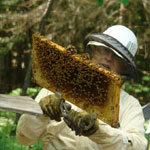 Surrounded by a swarm of 150,000 loudly buzzing bees on a hot summer day, a group of Marquette County teens turned nervous faces and trepidation into smiles and a education that they heard loud and clear – to protect rather than fear pollinators.
Surrounded by a swarm of 150,000 loudly buzzing bees on a hot summer day, a group of Marquette County teens turned nervous faces and trepidation into smiles and a education that they heard loud and clear – to protect rather than fear pollinators.
At first only two teens wearing protective beekeeping gear entered the apiary behind the Negaunee township home of Jim and Martha Hayward. The others wearing only shorts and t-shirts soon approached when they discovered that honeybees are not aggressive.
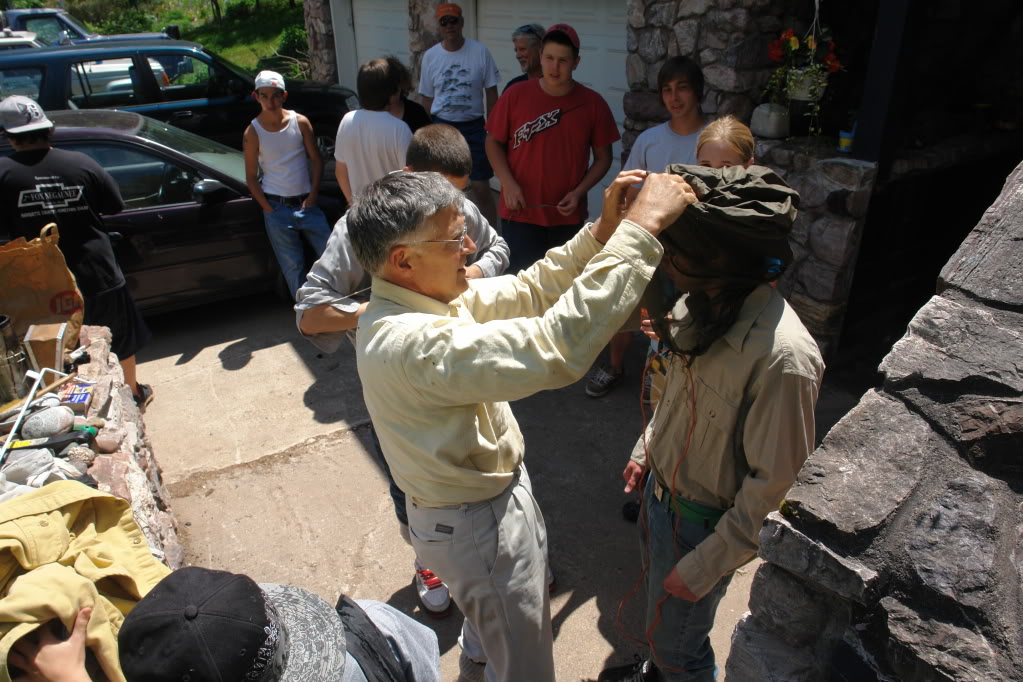
Beekeeper Jim Hayward, a Marquette dentist, fits a protective suit on Zaagkii Project volunteer Elliott Burdick, 17, a Marquette Senior High School (MSHS) senior and Taylor Dianich, 16, MSHS junior (left behind Hayward), as the Zaagkii group of teens prepare to check out the honeybee hives on June 25, 2009 in the back yard of Hayward's home in Negaunee Township, MI. (Photo by Greg Peterson)
Bees and butterflies “are a part of the web of life because they pollinate all the flowers and fruit trees that provide us with food,” said Dr. Jim Hayward, a Marquette dentist who has four honeybee hives on a shaded hillside.
The teens literally got up close and personal with the honeybees by inspecting honeycomb trays each covered with about 3,000 busy bees and even handled a drone that Hayward explained do not have stingers like the rest of the colony and are easily identified by a larger round abdomen and bigger eyes.
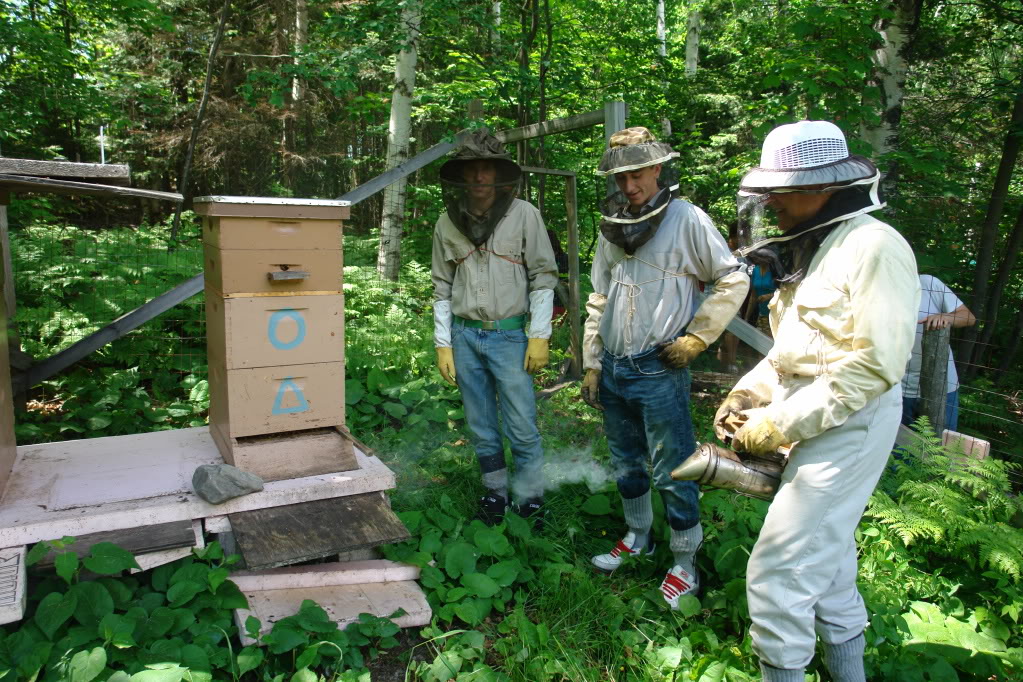
Beekeeper Jim Hayward (right) of Negaunee Township, MI explains how to operate a smoker to Taylor Dianich, 16, a Marquette Senior High School (MSHS) junior (center) and Elliott Burdick (left), 17, MSHS senior on June 25, 2009. Hayward explained the smoker calms bees because they protect their honey by gorging themselves with it fearing there is a fire and they may need to flee with the valuable sticky gold to make a new nest. Zaagkii Project teens visited Hayward's hives in 2008 and 2009. (Photo by Greg Peterson)
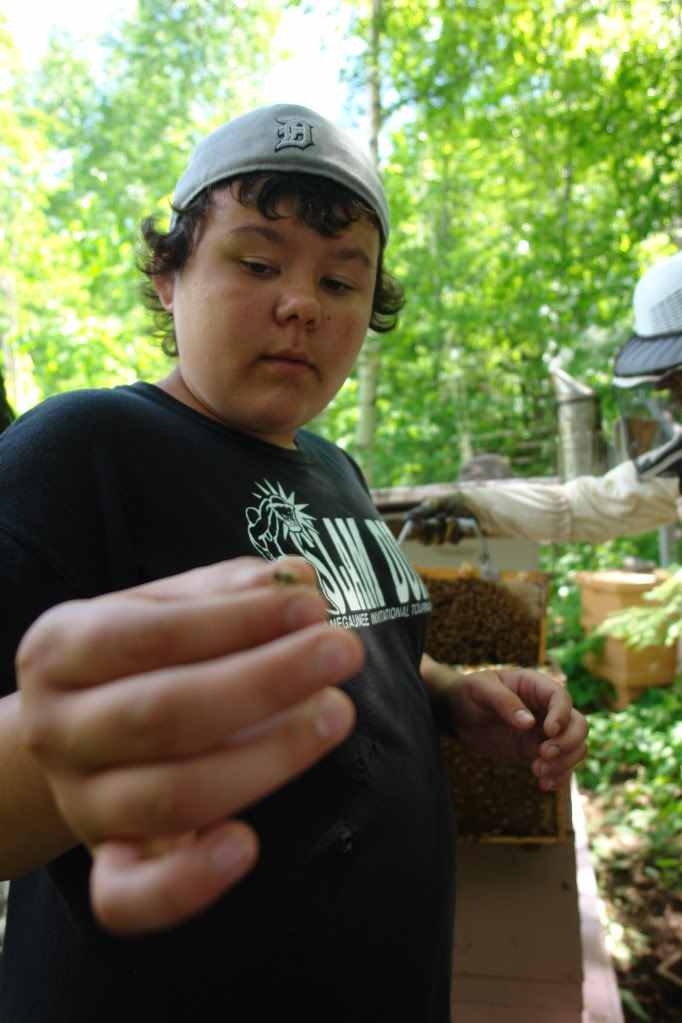
Zaagkii Project teen volunteer Anatoly Nelson holds a honeybee drone, that doesn't have a stinger and can't even feed itself but has the vital duty of mating with the queen. The teens were amazed that drones can not sting. (Photo by Greg Peterson)
“It doesn’t have a stinger? Are you positive?,” asked apprehensive teen Keith Gelsinger of Marquette.
“I am positive,” Hayward said confidently while carefully handing the struggling drone to Gelsinger. “You can grab on to it – it won’t sting you.”
In his soft-spoken, calm demeanor that relaxed the teens and the bees, Hayward said “you can stand a lot closer if you want, you won’t get stung.”
“The sole purpose of the drone is to mate with the queen. Otherwise it has no function. It can’t even feed itself. The other worker bees have to feed the drones.”
The teens let out an audible but soft gasp when Hayward pulled out a tray that was dripping with honey and packed with bees.
“Oooohh,” several of the astonished youths said at once.
Pointing to the edge of the honey-oozing tray in the bright sun, Hayward said “you can see the glistening of honey there.”
“It’s awesome,’ said 13-year-old eighth grader Tanya Nelson of Ishpeming. “Look at it, it’s honey, it’s dripping.”
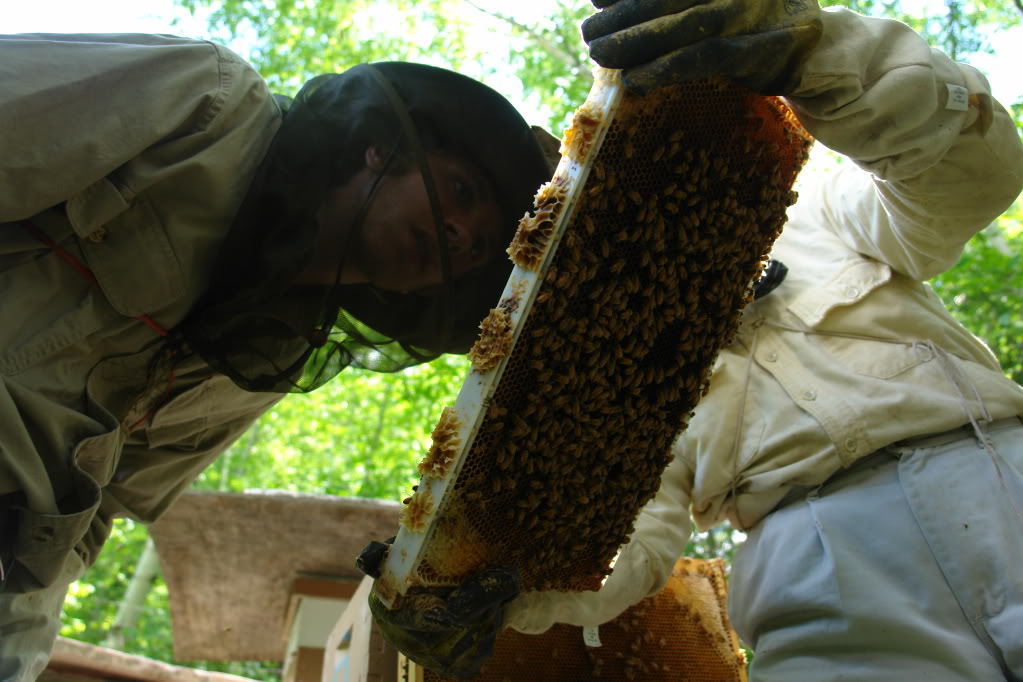
Zaagkii Project volunteer 17-year-old Elliott Burdick of Marquette, MI inspects a honeycomb oozing with honey and covered with thousands of honeybees that is being held by veteran beekeeper Dr. Jim Hayward. (Photo by Greg Peterson)
The teens also visited a bee farm along the Dead River operated by Dr. Lisa Long and Lee Ossenheimer in Negaunee Township and heard from beekeeper Jon Kniskern of Marquette.
Teen Anatoly Nelson was impressed that he was able to stand in the huge swarm and not get stung.
“Holy cow, that’s a lot of bees,” said Nelson, who also handled a honeybee drone that doesn’t have a stinger.
Student Anatoly Nelson also stood in a thick warm of bees and watched with amazement as they buzzed around his body and even bumped him without stinging or becoming alarmed.
Honeybees often have “sacks of yellow or orange pollen on its legs,” Hayward said. “They are busy bringing their nectar and pollen back to the hive.”
“You can learn a lot about the health of the hive by just looking at the flow of the bees coming in and out of the hive,” Hayward said as the heavy bees bounced in for landings.
In its second summer, the three-year Zaagkii Wings and Seeds Project protects pollinators through habitat creation that includes teenagers constructing dozens of bee and butterfly houses while helping native plants flourish by distributing and planting tens of thousands indigenous seeds.
Billions of bees of have died worldwide in an ongoing syndrome dubbed Colony Collapse Disorder (CCD). Suspected causes for CCD include pollution, pesticides, climate change and habitat destruction.
Bees have always been killed by a wide-range of predators.
Natural bee killers include black bears that raid hives for honey, bald-faced hornets who kill the queen and feast on the colony, birds that pick them off in mid-air and skunks who scratch on the hive with an insatiable taste for guard bees.
Feral and commercial hives are attacked by viruses, bacteria and parasites like a tracheal mite that infests honeybee airways and blood-sucking mites that infect and feed on adult and larval bees causing wings deformities.
Hayward uses electric fences to protect bees from persistent bears and elevates hives on cinder blocks to discourage skunks.
“That makes the skunks have to stand up, so their bellies are exposed and the bees can sting them more easily,” Hayward said.
Experts say bee colonies have declined 70 to 90 percent in the past quarter century. Albert Einstein predicted humans would die within four years if bees disappeared.
“People get into beekeeping to sell their pollination services to orchards around the country” including “apple and cherry orchards in Michigan,” Hayward said.
“I got into raising bees after local bee populations died out because of some disease and we did not have anything to pollinate” our fruits and vegetables, Hayward said.
The teens learned about beekeeper tools like honeycomb trays, frame grippers, a hive tool and a bee brush.
“You can brush them off an area with this gentle brush and it won’t damage the bees,” Hayward said.
While reassuring the teens that “honeybees tend to be docile,” Hayward donned himself and two youths in protective gear including a bee veil and gloves.
“If I make a false step and jar the hive or move to quickly it keeps me from being stung,” he said. “Honeybees die if they sting you, so they are not anxious to sting unless they are protecting themselves or the hive.”
“The queen excluder keeps the queen from getting up into the honey chambers and laying eggs so you don’t get larval bees into the honey,” he said. “These two chambers are the brood chambers, where the hive raises its new bees.”
During the summer, the queen “lays close to a thousand eggs a day,” Hayward said. “It takes 21 days for a bee to develop.”
Using a smoker that burns dried sumac, Hayward said the smoke “simulates a forest fire” triggering a protective instinct that causes the bees “to gorge themselves with honey in preparation for leaving the hive.”
Hayward explained that the bitter sumac burning in his bee smoker makes a great tea that tastes like lemon.
Later the teens made sumac iced tea, add a drop of Hayward’s honey and served it to Zaagkii Project supporters at the annual CTI Midsummer Festival at Presque Isle in Marquette. The youths made other natural hors d’oeuvres like honey and wild mint in a tiny appetizer cup.
The smoker causes the bees to quickly consume honey for possible transport to a new hive and the honey relaxes the bees so they won’t sting while being handled.
“When they are gorged with honey they are more docile,” he said. “The key is moving slowly and trying to be a gentle as you can be – so the bees don’t get too excited.”
“Drones develop from unfertilized eggs, worker bees are developed from fertilized eggs,” Hayward said.
“If they need to make a queen they take worker larva and feed it a special extract from their heads called Royal Jelly and that larva grows into a queen instead of a worker.”
The teens likely have “never been that close to a bee hive before,” said Jim Rule, a child care counselor at Marquette County Youth Home.
“Even the kids that did not have any protective gear were right up close too,” Rule said. “I was amazed at how brave they were.”

Hi Jim,
It’s wonderful to see you on the net helping to educate teens about bees. The information is vital and what you are doing may encourage future bee keepers. I, too have learned a great deal just reading this site! Thank you!
Dear Jim,
You are doing a lovely job educating the new generation about bees and beekeeping. I am not a beekeepers but a supplier of protective clothing for the beekeepers. I love to read about bees and have learnt a lot about beekeeping just by reading articles like yours. Now I am pllaning to keep Bees myself.
Thank you.
Hi, Jim. So great to see you and this article. Please pass along my love to your family. And, thank you again for all your generosity shared to John and I in 2000-2001.